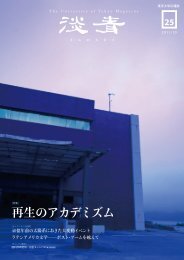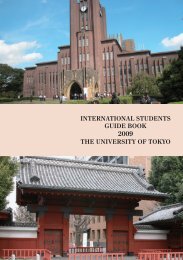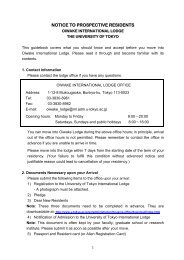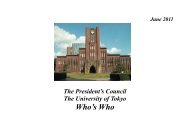brochure
brochure
brochure
Create successful ePaper yourself
Turn your PDF publications into a flip-book with our unique Google optimized e-Paper software.
Historiographical Institute<br />
http://www.hi.u-tokyo.ac.jp/index.html<br />
There is still an abundance of historical<br />
resources left in Japan, an amount<br />
unprecedented elsewhere. Our Institute<br />
collects records on Japanese history from<br />
ancient times to the Meiji Restoration,<br />
from around the country and around the<br />
world. Through our research on them we<br />
compile and publish historiographies that<br />
form the foundation of Japanese historical<br />
research. The Historiographical Institute<br />
has been carrying out this work for over<br />
100 years, and we have published over<br />
1000 historiographical works aimed at<br />
both academic and wider circles. Our<br />
investigative and acquisition work has<br />
allowed us to obtain copies of historical<br />
records, as well as many invaluable<br />
original manuscripts, such as the Shimazu<br />
documents, which are national treasures.<br />
We strive to preserve and manage these<br />
records, and provide researchers access<br />
to them for perusal.<br />
In recent years, we have turned our<br />
focus to research on visual sources, such<br />
as portraits and picture scrolls, and on<br />
historical information using computers.<br />
The Historiographical Institute is working<br />
at various ventures to expand the possibilities<br />
of historical research.<br />
Departments<br />
Ancient Materials, Medieval Materials,<br />
Early Modern Materials, Old Documents and<br />
Diaries, Special Materials<br />
Affiliated Research Institutions<br />
Center for the Study of Visual Sources,<br />
International Center for the Digitization of<br />
Premodern Japanese Sources<br />
Institute of Molecular and<br />
Cellular Biosciences<br />
http://www.iam.u-tokyo.ac.jp/index.html<br />
The Institute of Molecular and Cellular<br />
Biosciences (IMCB) consists of 330<br />
academic and administrative staff members,<br />
postdoctoral fellows and graduate<br />
students and carries out interdisciplinary<br />
research to understand living organisms<br />
at the molecular level. IMCB supports<br />
creative research in a wide range of fields:<br />
protein structure, cell division, regulation<br />
of gene expression, role of non-coding<br />
RNA, cytoskeleton, signal transduction,<br />
nervous systems, stem cells, cancer and<br />
adult diseases. IMCB acts as a hub in the<br />
field of structural biology in cooperation<br />
with the University of Tokyo Synchrotron<br />
Radiation Research Organization. IMCB<br />
is also advancing cutting edge research<br />
The Institute for Cosmic Ray Research<br />
carries out interdisciplinary research on<br />
the Universe and elementary particles<br />
through the study of cosmic particles from<br />
outer space. For example, neutrinos have<br />
given an insight into the inner dynamics of<br />
celestial objects which cannot be seen by<br />
optical observation, and also provided information<br />
about their tiny masses through<br />
the phenomena of neutrino oscillation.<br />
The keywords of the Institute’s mission<br />
are “underground” and “overseas.” As the<br />
effects of cosmic rays are reduced, underground<br />
spaces are suited to observing the<br />
faint signs of neutrinos. At Kamioka Obinto<br />
drug development and has a highly<br />
active program for collaboration with<br />
industry. To further expand and accelerate<br />
these efforts, IMCB has established the<br />
Research Center for Epigenetic Diseases<br />
and Center of Crystallography for Challenging<br />
Proteins. IMCB accepts graduate<br />
students from the Graduate Schools of<br />
Science, Agriculture, Pharmaceutical Science,<br />
Medicine, Engineering and Frontier<br />
Sciences and contributes to education at<br />
the University of Tokyo.<br />
Research Departments<br />
Core Research Laboratories<br />
Next generation sequencers that read 1Tb DNA equivalent to<br />
300 human genomes per week.<br />
Annexed Research Facilities<br />
Center for Structural Biology of Challenging<br />
Proteins, Life Science Division, Synchrotron<br />
Radiation Research Organization<br />
Institute for Cosmic Ray Research<br />
http://www.icrr.u-tokyo.ac.jp/index_eng.html<br />
servatory, the Super-Kamiokande detector<br />
presses on with neutrino research and<br />
an experiment searching for dark matter<br />
particles is in progress. At the same time<br />
a project to observe gravitational waves<br />
predicted by Einstein’s General Theory of<br />
Relativity is under construction. Overseas<br />
deserts are suitable for studying luminescent<br />
phenomena due to cosmic particles<br />
entering the atmosphere. In Tibet, research<br />
into high-energy cosmic gamma<br />
rays is being carried out. In addition, an<br />
experiment is being carried out in Utah in<br />
the USA to unlock the puzzle of the most<br />
energetic cosmic rays.<br />
Research Divisions<br />
Astrophysics and Gravity, High Energy Cosmic<br />
Ray, Neutrino and Astroparticle<br />
Research Facilities<br />
Norikura Observatory, Akeno Observatory,<br />
Kamioka Observatory, Research Center for<br />
Cosmic Neutrinos<br />
47









